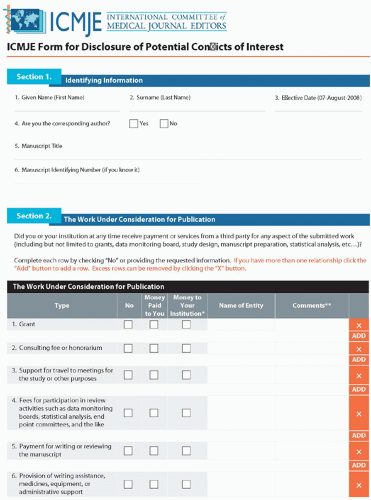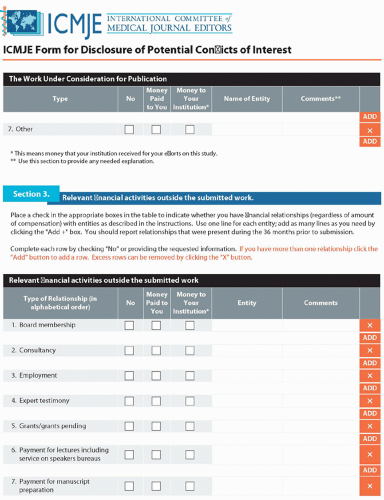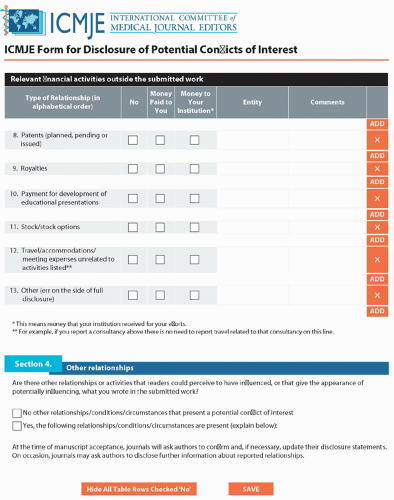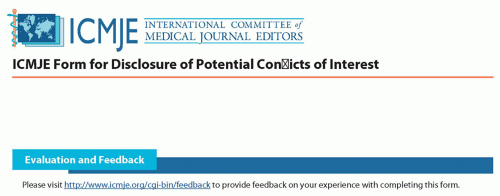Conflict of Interest
Andrew H. Murr
Susan J. Murr
The views expressed in this chapter are the personal views of the authors and do not represent the views of their respective employers.
Conflicts of interest between physicians and industry have received much attention in the headlines lately, perhaps driven by the increasing complexity of potential relationships. Relationships between the physician community and industry are important in helping patients through the development of new medicines and technologies that enable patients to live longer and healthier lives. In short, these relationships are essential to medical innovation. At the same time, these relationships must be managed in a transparent, ethical manner to insure that first and foremost, the best interests of the patient are kept in the forefront. This chapter explores the definition of a conflict using examples from the news, the types of relationships that may pose conflicts, some of the rules governing conflicts, and best practices in the management of conflicts.
DEFINITION OF CONFLICT OF INTEREST
The definition of conflict of interest is variable, but according to Merriam-Webster’s online dictionary a conflict of interest is “a conflict between the private interests and the official responsibilities of a person in a position of trust” (1). This conflict may commonly be based upon financial rewards, but it can also be based upon a set of circumstances that achieves a specific outcome. An example of an outcome as a component of a conflict of interest is when a judge must excuse himself or herself because of a type of knowledge or relationship that is possessed that may then skew or give the appearance of skewing the outcome of a legal case. Another term, duality of interest, is used when a person has two roles, which may lead to an influence on judgment. An example of duality of interest is when a board member of a foundation that gives research grants is also part of a team that has applied for one of the foundation’s grants.
Several examples of possible perceived conflicts of interest have been prominent in news reports over the past several years, and these examples can be instructive. In 2009, Liz Kowalczyk of the Boston Globe wrote an article about a potential conflict of interest at Massachusetts General Hospital involving Dr. Joseph Biederman who oversaw a study involving risperidone in treating psychosis in children under age 10 between 2002 and 2005. Johnson and Johnson, the company that manufactured the drug via Janssen Pharmaceuticals, had given $700,000 to support the research center at Massachusetts General, and it was reported that Dr. Biederman appeared to have received $1.5 million in consulting and speaking fees from them. This income was allegedly not reported in a timely fashion to Harvard University. Although Dr. Biederman did not own stock in J&J, J&J was alleged to be intimately involved in the research center that Dr. Biederman oversaw. As Dr. Marcia Angell summarized in a comment for the Boston Globe on March 20, 2009, “Even if you have the best intentions, it’s hard to remain objective about people who’ve been so good to you” (2). Whether or not the income and support from J&J influenced the outcome of ongoing research work is unknown. However, large amounts of monetary support for studies in the form of research center support and income and consulting fees can have the appearance of influencing the accumulation of objective results.
Another story depicting a possible conflict of interest involved the development and marketing of an orthopedic hip implant manufactured by DePuy. The implant was developed by several physicians including Dr. Thomas Schmalzried and Dr. Thomas Vail and was known as the ASR Implant. The implant was released in the United States in 2005 without undergoing FDA trials after being used abroad, but by 2008 there were over 200 problems reported with the implant, and by 2009 over 300 problems were reported. A high percentage of reported problems resulted in a need to replace the implant. DePuy was reportedly slow to react to information about problems with the
product and continued to market the device. The developers of the device were also reported to be supportive of it even in the face of mounting failure data. Dr. Schmalzried was reported as receiving $3.4 million in payments over a 2-year period for work and royalties related to the device. The company and the physicians were accused of continuing to support the device after data showed it to be failing at a high rate. Finally, DePuy pulled the device from the market (3). Taking this information at face value, news reports speculated that it appeared that financial incentives and profit may have interfered with timely decision making in light of accumulating negative clinical information concerning the clinical performance and failure rate of the device in which the doctors had a financial interest (4).
product and continued to market the device. The developers of the device were also reported to be supportive of it even in the face of mounting failure data. Dr. Schmalzried was reported as receiving $3.4 million in payments over a 2-year period for work and royalties related to the device. The company and the physicians were accused of continuing to support the device after data showed it to be failing at a high rate. Finally, DePuy pulled the device from the market (3). Taking this information at face value, news reports speculated that it appeared that financial incentives and profit may have interfered with timely decision making in light of accumulating negative clinical information concerning the clinical performance and failure rate of the device in which the doctors had a financial interest (4).
The main tool used to combat the appearance of conflict of interest is disclosure. Disclosure allows a person with a potential conflict to report the issue prior to beginning work on a study or publication or presentation. In this way, any judgmental body such as an editorial review board or an audience at a lecture can be apprised of the relationship of an individual to a technology or drug or research question. Disclosure also allows the possibility of screening slides or other presentation material by a disinterested third party to make sure that biased information is not being disseminated in a scientific or educational setting that awards educational credits to people who are in the audience. Obviously, one way to control conflict of interest in presented material would be to have a zero tolerance approach whereby any person who has any financial or other interest in a project or outcome would not be welcome to participate in publically speaking or writing about the subject. This extreme position, however, would essentially be a prohibition upon allowing some of the most creative and expert scientists and investigators from being involved in the education process. It would also deter experts from becoming involved in promising investigations that could have translational and commercial applications. Certainly, translational science should be encouraged and not discouraged as the benefit to society as a whole is an overriding principle. As a result, conflict of interest can be managed through a process of transparency rather than being prohibited outright.
CONFLICT OF INTEREST IN PUBLISHING
Because of variability in defining conflict of interest, each journal or publication theoretically can define its own individual set of standards for its authors and readers. Standardization, however, certainly has some advantages. The International Committee of Medical Journal Editors (ICMJE) has recently adopted a standard form for disclosure formally referred to as “ICMJE Form for Disclosure of Potential Conflicts of Interest” (5) (Fig. 207.1). This form has been embraced by many journals including JAMA (6,7). The form is a fairly simple PDF document that has four sections. Section 1 is identifying information. Section 2 elicits information about personal or institutional payment from a third party to support any aspect of the submitted work. This includes grants, consulting fees, travel support, fees for data monitoring or statistical analysis, fees for writing or reviewing the work, writing assistance or administrative support, or others. Section 3 probes financial activities outside of the submitted work, including relationships present during the 36 months prior to the actual submission. This includes board memberships, consultancies, employment, expert testimony, grants, payment for lectures, payment for manuscript preparation, patents, royalties, payment for developing educational presentations, stock options, travel accommodations and meeting expenses, or other. Finally, Section 4 asks for any other relevant information that the author can think of that may have influenced the work. Section 4 was added after a period of review and comment elicited feedback that itemizing every conceivable conflict, such as conflicts involving spouses or children, is impractical. To resolve this challenge, Section 4 was added as an open-ended section to allow the author to submit any other potential category of conflict that had been missed in the above sections (6). Not every otolaryngology—head and neck surgery-based journal has adopted this ICMJE form, but the thoroughness and thoughtfulness of this form is a relatively concise guide to what would be expected in disclosing all aspects of potential bias when submitting an article for publication consideration.
CONFLICT OF INTEREST IN RESEARCH
Recently, the National Institutes of Health (NIH) proposed the first major overhaul of conflict of interest guidelines in over a decade. Old standards triggered financial reporting at $10,000. The new guidelines require disclosure of support that exceeds $5,000. This includes reporting stock ownership, speaking fees, consulting arrangements, and other financial relationships with foundations or industry. Disclosure of these potential conflicts is to be made to the parent institution, and so the parent institution is therefore tasked with monitoring compliance with ethical standards. The parent institution is also responsible for allowing public scrutiny of any reported disclosure items. As a dual check on reporting, the Patient Protection and Affordable Care Act, commonly known as the Obama Health Care Plan, also included a “sunshine provision” that mandated that industry report to a government database any payment or gift to a physician greater than $10 (8,9).
INSTITUTIONAL CONFLICT OF INTEREST
Individuals are not the only people who can benefit from financial arrangements with industry. Very often, entire institutions have a stake in a certain technology or drug. A case in point involved a situation at the Cleveland Clinic. According to news reports, Delos M. Cosgrove, M.D., was the head of the Cleveland Clinic Foundation and had received royalties from a company called AtriCure.
AtriCure produced a surgical tool that was not specifically FDA approved for heart surgery in 2005, but the Cleveland Clinic had been conducting research on using the tool to ablate atrial fibrillation. The Cleveland Clinic itself apparently also had an investment interest in the company. Yet, in conducting the research, patients were not initially made aware of the institution’s financial interest and the foundation director’s financial relationship to the technology. Eventually, Dr. Cosgrove removed himself from overseeing the Cleveland Clinic Foundation’s investment section, and the institution created the Cleveland Clinic’s Innovation Management and Conflict of Interest Committee to vet promising technologies and their relationship to the organization (10). Thus, Cleveland Clinic developed an individual approach to managing the institution’s expertise, creativity in translational research, and economic investments in a presumably ethical fashion. Other organizations such as the American Association of Medical Colleges and the Institute of Medicine (IOM) have constructed guidelines and recommendations to allow institutions to ethically manage conflict of interest while still benefiting from expertise in translational research and industry partnerships (11). Uniformity in adopting these guidelines has been relatively unsuccessful as recently shown in a report published by Ehringhaus in Journal of the American Medical Association, which showed that only 38% of institutions had policies which oversaw the institution’s own investment portfolio (12).
AtriCure produced a surgical tool that was not specifically FDA approved for heart surgery in 2005, but the Cleveland Clinic had been conducting research on using the tool to ablate atrial fibrillation. The Cleveland Clinic itself apparently also had an investment interest in the company. Yet, in conducting the research, patients were not initially made aware of the institution’s financial interest and the foundation director’s financial relationship to the technology. Eventually, Dr. Cosgrove removed himself from overseeing the Cleveland Clinic Foundation’s investment section, and the institution created the Cleveland Clinic’s Innovation Management and Conflict of Interest Committee to vet promising technologies and their relationship to the organization (10). Thus, Cleveland Clinic developed an individual approach to managing the institution’s expertise, creativity in translational research, and economic investments in a presumably ethical fashion. Other organizations such as the American Association of Medical Colleges and the Institute of Medicine (IOM) have constructed guidelines and recommendations to allow institutions to ethically manage conflict of interest while still benefiting from expertise in translational research and industry partnerships (11). Uniformity in adopting these guidelines has been relatively unsuccessful as recently shown in a report published by Ehringhaus in Journal of the American Medical Association, which showed that only 38% of institutions had policies which oversaw the institution’s own investment portfolio (12).
CONFLICT OF INTEREST IN MEDICAL PRACTICE
Conflicts of interest can be encountered in the direct delivery of health care. The federal government has identified this potential conflict and has through the legislature weighed in by developing laws that concern direct medical practice.
Stay updated, free articles. Join our Telegram channel

Full access? Get Clinical Tree







